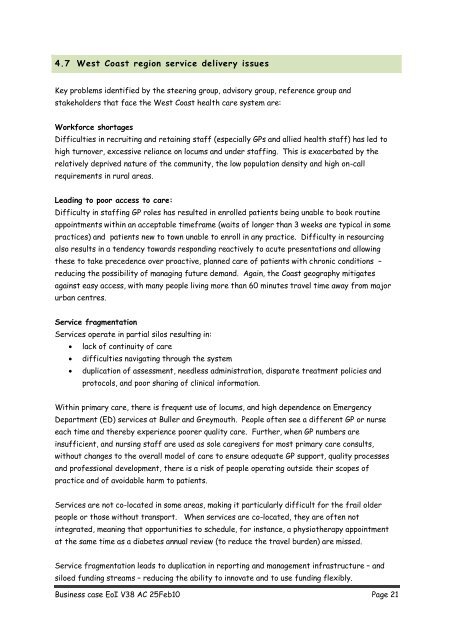Better Sooner More Convenient Primary Care - New Zealand Doctor
Better Sooner More Convenient Primary Care - New Zealand Doctor
Better Sooner More Convenient Primary Care - New Zealand Doctor
You also want an ePaper? Increase the reach of your titles
YUMPU automatically turns print PDFs into web optimized ePapers that Google loves.
4.7 West Coast region service delivery issues<br />
Key problems identified by the steering group, advisory group, reference group and<br />
stakeholders that face the West Coast health care system are:<br />
Workforce shortages<br />
Difficulties in recruiting and retaining staff (especially GPs and allied health staff) has led to<br />
high turnover, excessive reliance on locums and under staffing. This is exacerbated by the<br />
relatively deprived nature of the community, the low population density and high on-call<br />
requirements in rural areas.<br />
Leading to poor access to care:<br />
Difficulty in staffing GP roles has resulted in enrolled patients being unable to book routine<br />
appointments within an acceptable timeframe (waits of longer than 3 weeks are typical in some<br />
practices) and patients new to town unable to enroll in any practice. Difficulty in resourcing<br />
also results in a tendency towards responding reactively to acute presentations and allowing<br />
these to take precedence over proactive, planned care of patients with chronic conditions –<br />
reducing the possibility of managing future demand. Again, the Coast geography mitigates<br />
against easy access, with many people living more than 60 minutes travel time away from major<br />
urban centres.<br />
Service fragmentation<br />
Services operate in partial silos resulting in:<br />
lack of continuity of care<br />
difficulties navigating through the system<br />
duplication of assessment, needless administration, disparate treatment policies and<br />
protocols, and poor sharing of clinical information.<br />
Within primary care, there is frequent use of locums, and high dependence on Emergency<br />
Department (ED) services at Buller and Greymouth. People often see a different GP or nurse<br />
each time and thereby experience poorer quality care. Further, when GP numbers are<br />
insufficient, and nursing staff are used as sole caregivers for most primary care consults,<br />
without changes to the overall model of care to ensure adequate GP support, quality processes<br />
and professional development, there is a risk of people operating outside their scopes of<br />
practice and of avoidable harm to patients.<br />
Services are not co-located in some areas, making it particularly difficult for the frail older<br />
people or those without transport. When services are co-located, they are often not<br />
integrated, meaning that opportunities to schedule, for instance, a physiotherapy appointment<br />
at the same time as a diabetes annual review (to reduce the travel burden) are missed.<br />
Service fragmentation leads to duplication in reporting and management infrastructure – and<br />
siloed funding streams – reducing the ability to innovate and to use funding flexibly.<br />
Business case EoI V38 AC 25Feb10 Page 21

















